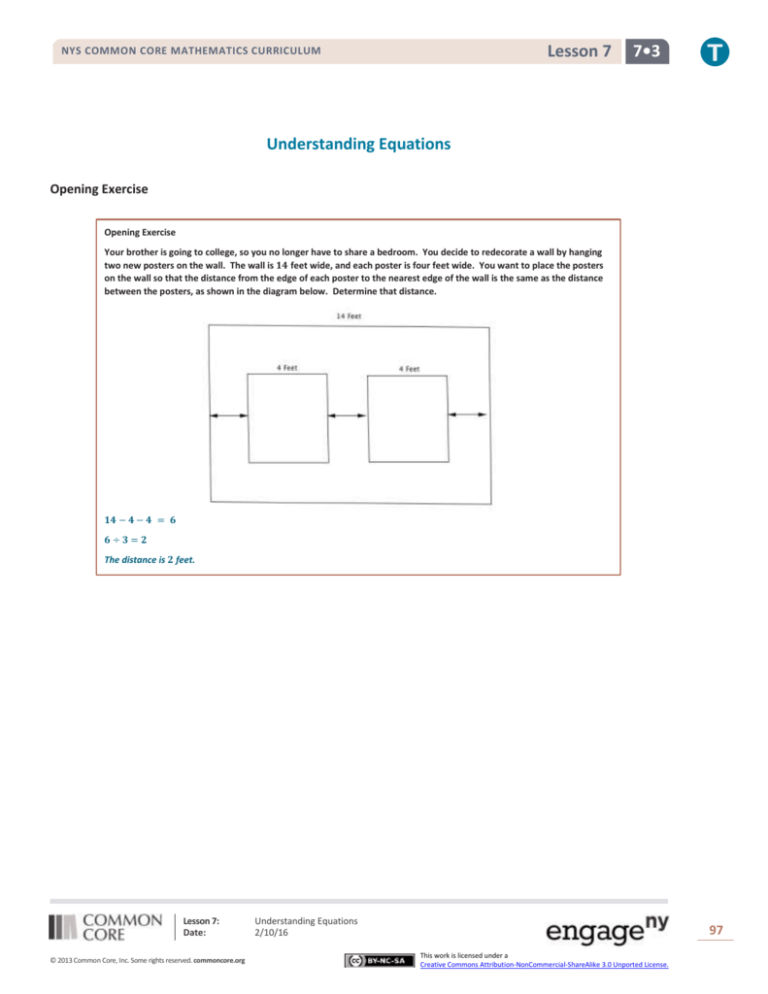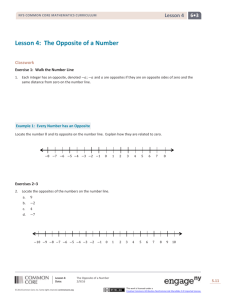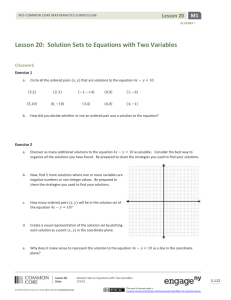
Lesson 7
NYS COMMON CORE MATHEMATICS CURRICULUM
7•3
Understanding Equations
Opening Exercise
Opening Exercise
Your brother is going to college, so you no longer have to share a bedroom. You decide to redecorate a wall by hanging
two new posters on the wall. The wall is 𝟏𝟒 feet wide, and each poster is four feet wide. You want to place the posters
on the wall so that the distance from the edge of each poster to the nearest edge of the wall is the same as the distance
between the posters, as shown in the diagram below. Determine that distance.
𝟏𝟒 − 𝟒 − 𝟒 = 𝟔
𝟔÷𝟑 =𝟐
The distance is 𝟐 feet.
Lesson 7:
Date:
© 2013 Common Core, Inc. Some rights reserved. commoncore.org
Understanding Equations
2/10/16
97
This work is licensed under a
Creative Commons Attribution-NonCommercial-ShareAlike 3.0 Unported License.
Lesson 7
NYS COMMON CORE MATHEMATICS CURRICULUM
7•3
Your parents are redecorating the dining room and want to place two rectangular wall sconce lights that are 𝟐𝟓 inches
wide along a 𝟏𝟎 foot, 𝟖 inch wall, so that the distance between the lights and the distances from each light to the nearest
edge of the wall are all the same. Design the wall and determine the distance.
Scaffolding:
Review that 12 inches = 1 foot.
𝟐𝟓
𝟏
=𝟐
𝒇𝒆𝒆𝒕
𝟏𝟐
𝟏𝟐
𝟐
𝟏
𝟏
(𝟏𝟎 − 𝟐
−𝟐 )÷𝟑
𝟑
𝟏𝟐
𝟏𝟐
𝟐𝟓 𝒊𝒏𝒄𝒉𝒆𝒔 =
𝟐
𝟑
𝟐
𝟑
𝟏𝟎 𝒇𝒆𝒆𝒕 = 𝟏𝟎 × 𝟏𝟐 + × 𝟏𝟐 = 𝟏𝟐𝟎 + 𝟖 = 𝟏𝟐𝟖 𝒊𝒏𝒄𝒉𝒆𝒔
𝟖
𝟏
𝟏
(𝟏𝟎 − 𝟐 − 𝟐 ) ÷ 𝟑
𝟏𝟐
𝟏𝟐
𝟏𝟐
𝟔
(𝟔 ) ÷ 𝟑
𝟏𝟐
𝟏
𝟏𝟑
𝟔 ÷𝟑=
÷𝟑
𝟐
𝟐
𝟏𝟑 𝟏 𝟏𝟑
𝟏
× =
= 𝟐 𝒇𝒆𝒆𝒕
𝟐
𝟑
𝟔
𝟔
Lesson 7:
Date:
© 2013 Common Core, Inc. Some rights reserved. commoncore.org
OR
(𝟏𝟐𝟖 − 𝟐𝟓 − 𝟐𝟓) ÷ 𝟑
𝟕𝟖 ÷ 𝟑
𝟐𝟔 𝒊𝒏𝒄𝒉𝒆𝒔
Understanding Equations
2/10/16
98
This work is licensed under a
Creative Commons Attribution-NonCommercial-ShareAlike 3.0 Unported License.
Lesson 7
NYS COMMON CORE MATHEMATICS CURRICULUM
7•3
Let the distance between a light and the nearest edge of a wall be 𝒙 ft. Write an expression in terms of 𝒙 for the total
length of the wall, and then use the expression and the length of the wall given in the problem to write an equation that
can be used to find that distance.
𝟑𝒙 + 𝟐
𝟏
𝟏
+𝟐
𝟏𝟐
𝟏𝟐
𝟑𝒙 + 𝟐
𝟏
𝟏
𝟐
+𝟐
= 𝟏𝟎
𝟏𝟐
𝟏𝟐
𝟑
MP.7
Now write an equation where 𝒚 stands for the number of inches: Let the distance between a light and the nearest edge
of a wall be 𝒚 in. Write an expression in terms of 𝒚 for the total length of the wall, and then use the expression and the
length of the wall (in inches) given in the problem to write an equation that can be used to find that distance (in inches).
𝟐
𝟏
feet = 𝟐𝟓 inches; therefore, the expression is 𝟑𝒚 + 𝟐𝟓 + 𝟐𝟓.
𝟏𝟐
𝟐
𝟑
𝟏𝟎 feet = 𝟏𝟐𝟖 inches; therefore, the equation is 𝟑𝒚 + 𝟐𝟓 + 𝟐𝟓 = 𝟏𝟐𝟖.
What value(s) of 𝒚 makes the second equation true: 𝟐𝟒, 𝟐𝟓, or 𝟐𝟔?
𝒚 = 𝟐𝟒
𝟑𝒚 + 𝟐𝟓 + 𝟐𝟓 = 𝟏𝟐𝟖
𝟑(𝟐𝟒) + 𝟐𝟓 + 𝟐𝟓 = 𝟏𝟐𝟖
𝟕𝟐 + 𝟐𝟓 + 𝟐𝟓 = 𝟏𝟐𝟖
𝟏𝟐𝟐 = 𝟏𝟐𝟖
False
𝒚 = 𝟐𝟓
𝟑𝒚 + 𝟐𝟓 + 𝟐𝟓 = 𝟏𝟐𝟖
𝟑(𝟐𝟓) + 𝟐𝟓 + 𝟐𝟓 = 𝟏𝟐𝟖
𝟕𝟓 + 𝟐𝟓 + 𝟐𝟓 = 𝟏𝟐𝟖
𝟏𝟐𝟓 = 𝟏𝟐𝟖
False
𝒚 = 𝟐𝟔
𝟑𝒚 + 𝟐𝟓 + 𝟐𝟓 = 𝟏𝟐𝟖
𝟑(𝟐𝟔) + 𝟐𝟓 + 𝟐𝟓 = 𝟏𝟐𝟖
𝟕𝟖 + 𝟐𝟓 + 𝟐𝟓 = 𝟏𝟐𝟖
𝟏𝟐𝟖 = 𝟏𝟐𝟖
True
Since substituting 𝟐𝟔 for 𝒚 results in a true equation, the distance between the light and the nearest edge of the wall
should be 𝟐𝟔 𝒊𝒏.
Reflection of process above:
How did the change in the dimensions on the second problem change how you approached the problem?
The fractional width of 10
2
feet makes the arithmetic more difficult, and the width of the posters
3
expressed in a different unit than the width of the room makes the problem more difficult.
Since this problem is more difficult than the first, what additional steps are required to solve the problem?
The widths must be in the same units. Therefore, you must either convert 10
2
feet to inches or convert
3
25 inches to feet.
Describe the process of converting the units.
To convert 25 inches to feet, divide the 25 inches by 12, and write the quotient as a mixed number. To
convert 10
2
2
feet to inches, multiply the whole number 10 by 12, and then multiply the fractional part,
3
, by 12; add the parts together to get the total number of inches.
3
After looking at both of the arithmetic solutions, which one seemed most efficient and why?
Converting the width of the room from feet to inches made the overall problem shorter and easier
because after converting the width, all of the dimensions ended up being whole numbers and not
fractions.
Lesson 7:
Date:
© 2013 Common Core, Inc. Some rights reserved. commoncore.org
Understanding Equations
2/10/16
99
This work is licensed under a
Creative Commons Attribution-NonCommercial-ShareAlike 3.0 Unported License.
Lesson 7
NYS COMMON CORE MATHEMATICS CURRICULUM
Does it matter which equation you use when determining which given values make the equation true? Explain
how you know.
7•3
Yes, since the values were given in inches, the equation 3𝑦 + 25 + 25 = 128 can be used because each
term of the equation is in the same unit of measure.
If one uses the other equation, what must be done to obtain the solution?
If the other equation were used, then the given values of 24, 25, and 26 inches need to be converted to
2, 2
1
1
, and 2 feet, respectively.
12
6
Example 1
The example is a consecutive integer word problem. A tape diagram is used to model an arithmetic solution in part (a).
Replacing the first bar (the youngest sister’s age) in the tape diagram with 𝑥 years provides an opportunity for students
to visualize the meaning of the equation created in part (b).
Example 1
The ages of three sisters are consecutive integers. The sum of their ages is 𝟒𝟓. Find their ages.
MP.4
a.
Use a tape diagram to find their ages.
Youngest Sister
2nd Sister
1
Oldest Sister
1
𝟒𝟓
1
𝟒𝟓 − 𝟑 = 𝟒𝟐.
𝟒𝟐 ÷ 𝟑 = 𝟏𝟒.
b.
Youngest Sister:
𝟏𝟒 years old
2nd
Sister:
𝟏𝟓 years old
Oldest Sister:
𝟏𝟔 years old
If the youngest sister is 𝒙 years old, describe the ages of the other two sisters in terms of 𝒙, write an
expression for the sum of their ages in terms of 𝒙, and use that expression to write an equation that can be
used to find their ages.
Youngest Sister:
𝒙 years old
2nd Sister:
(𝒙 + 𝟏) years old
Oldest Sister:
(𝒙 + 𝟐) years old
Sum of their ages:
𝒙 + (𝒙 + 𝟏) + (𝒙 + 𝟐)
Equation:
𝒙 + (𝒙 + 𝟏) + (𝒙 + 𝟐) = 𝟒𝟓
Lesson 7:
Date:
© 2013 Common Core, Inc. Some rights reserved. commoncore.org
Understanding Equations
2/10/16
100
This work is licensed under a
Creative Commons Attribution-NonCommercial-ShareAlike 3.0 Unported License.
Lesson 7
NYS COMMON CORE MATHEMATICS CURRICULUM
c.
Determine if your answer from part (a) is a solution to the equation you wrote in part (b).
𝒙 + (𝒙 + 𝟏) + (𝒙 + 𝟐) = 𝟒𝟓
𝟏𝟒 + (𝟏𝟒 + 𝟏) + (𝟏𝟒 + 𝟐) = 𝟒𝟓
𝟒𝟓 = 𝟒𝟓
Scaffolding:
True
Let 𝑥 be an integer; write an algebraic expression that represents one more than
that integer.
7•3
Review what is meant by
consecutive integers–positive
and negative whole numbers
that increase or decrease by 1
unit. For example: −2, −1, 0.
𝑥+1
Write an algebraic expression that represents two more than that integer.
𝑥+2
Discuss how the unknown unit in a tape diagram represents the unknown integer, represented by 𝑥. Consecutive
integers begin with the unknown unit; then, every consecutive integer thereafter increases by 1 unit.
Lesson 7:
Date:
© 2013 Common Core, Inc. Some rights reserved. commoncore.org
Understanding Equations
2/10/16
101
This work is licensed under a
Creative Commons Attribution-NonCommercial-ShareAlike 3.0 Unported License.
Lesson 7
NYS COMMON CORE MATHEMATICS CURRICULUM
7•3
Exercise
Instruct students to complete the following exercise individually and discuss the solution as a class.
Exercise
1.
Sophia pays a $𝟏𝟗. 𝟗𝟗 membership fee for an online music store.
a.
If she also buys two songs from a new album at a price of $𝟎. 𝟗𝟗 each, what is the total cost?
$𝟐𝟏. 𝟗𝟕
b.
If Sophia purchases 𝒏 songs for $𝟎. 𝟗𝟗 each, write an expression for the total cost.
𝟎. 𝟗𝟗𝒏 + 𝟏𝟗. 𝟗𝟗
c.
Sophia’s friend has saved $𝟏𝟏𝟖 but isn’t sure how many songs she can afford if she buys the membership and
some songs. Use the expression in part (b) to write an equation that can be used to determine how many
songs Sophia’s friend can buy.
𝟎. 𝟗𝟗𝒏 + 𝟏𝟗. 𝟗𝟗 = 𝟏𝟏𝟖
d.
Using the equation written in part (c), can Sophia’s friend buy 𝟏𝟎𝟏, 𝟏𝟎𝟎, or 𝟗𝟗 songs?
𝒏 = 𝟗𝟗
𝟎. 𝟗𝟗𝒏 + 𝟏𝟗. 𝟗𝟗 = 𝟏𝟏𝟖
𝟎. 𝟗𝟗(𝟗𝟗) + 𝟏𝟗. 𝟗𝟗 = 𝟏𝟏𝟖
𝟗𝟖. 𝟎𝟏 + 𝟏𝟗. 𝟗𝟗 = 𝟏𝟏𝟖
𝒏 = 𝟏𝟎𝟏
𝟎. 𝟗𝟗𝒏 + 𝟏𝟗. 𝟗𝟗 = 𝟏𝟏𝟖
𝟎. 𝟗𝟗𝒏 + 𝟏𝟗. 𝟗𝟗 = 𝟏𝟏𝟖
𝟎. 𝟗𝟗(𝟏𝟎𝟎) + 𝟏𝟗. 𝟗𝟗 = 𝟏𝟏𝟖
𝟎. 𝟗𝟗(𝟏𝟎𝟏) + 𝟏𝟗. 𝟗𝟗
𝟗𝟗 + 𝟏𝟗. 𝟗𝟗 = 𝟏𝟏𝟖
𝟏𝟏𝟖 = 𝟏𝟏𝟖
True
𝒏 = 𝟏𝟎𝟎
𝟏𝟏𝟖. 𝟗𝟗 = 𝟏𝟏𝟖
False
= 𝟏𝟏𝟖
𝟗𝟗. 𝟗𝟗 + 𝟏𝟗. 𝟗𝟗 = 𝟏𝟏𝟖
𝟏𝟏𝟗. 𝟗𝟖 = 𝟏𝟏𝟖
False
Lesson 7:
Date:
© 2013 Common Core, Inc. Some rights reserved. commoncore.org
Understanding Equations
2/10/16
102
This work is licensed under a
Creative Commons Attribution-NonCommercial-ShareAlike 3.0 Unported License.
Lesson 7
NYS COMMON CORE MATHEMATICS CURRICULUM
7•3
Problem Set Sample Solutions
1.
Check whether the given value is a solution to the equation.
a.
𝟒𝒏 − 𝟑 = −𝟐𝒏 + 𝟗
𝒏=𝟐
True
b.
𝟗𝒎 − 𝟏𝟗 = 𝟑𝒎 + 𝟏
𝒎=
𝟏𝟎
𝟑
True
c.
𝟑(𝒚 + 𝟖) = 𝟐𝒚 − 𝟔
𝒚 = 𝟑𝟎
False
2.
Tell whether each number is a solution to the problem modeled by the following equation.
Mystery Number:
Five more than −𝟖 times a number is 𝟐𝟗. What is the number?
Let the mystery number be represented by 𝒏.
The equation is:
a.
𝟓 + (−𝟖)𝒏 = 𝟐𝟗.
Is 𝟑 a solution to the equation? Why or why not?
No, because 𝟓 − 𝟐𝟒 ≠ 𝟐𝟗.
b.
Is −𝟒 a solution to the equation? Why or why not?
No, because 𝟓 + 𝟑𝟐 ≠ 𝟐𝟗.
c.
Is −𝟑 a solution to the equation? Why or why not?
Yes, because 𝟓 + 𝟐𝟒 = 𝟐𝟗.
d.
What is the mystery number?
−𝟑 because 𝟓 more than −𝟖 times −𝟑 is 𝟐𝟗.
3.
The sum of three consecutive integers is 𝟑𝟔.
a.
Find the smallest integer using a tape diagram.
1st Integer
2nd Integer
1
3rd Integer
1
𝟑𝟔
1
𝟑𝟔 − 𝟑 = 𝟑𝟑
𝟑𝟑 ÷ 𝟑 = 𝟏𝟏
The smallest integer is 𝟏𝟏.
Lesson 7:
Date:
© 2013 Common Core, Inc. Some rights reserved. commoncore.org
Understanding Equations
2/10/16
103
This work is licensed under a
Creative Commons Attribution-NonCommercial-ShareAlike 3.0 Unported License.
Lesson 7
NYS COMMON CORE MATHEMATICS CURRICULUM
b.
7•3
Let 𝒏 represent the smallest integer. Write an equation that can be used to find the smallest integer.
Smallest integer: 𝒏
2nd integer: (𝒏 + 𝟏)
3rd integer: (𝒏 + 𝟐)
Sum of the three consecutive integers: 𝒏 + (𝒏 + 𝟏) + (𝒏 + 𝟐)
Equation: 𝒏 + (𝒏 + 𝟏) + (𝒏 + 𝟐) = 𝟑𝟔
c.
Determine if each value of 𝒏 below is a solution to the equation in part (b).
𝒏 = 𝟏𝟐. 𝟓
No, it is not an integer and it does not make a true equation.
𝒏 = 𝟏𝟐
No, it does not make a true equation.
𝒏 = 𝟏𝟏
Yes, it makes a true equation.
Lesson 7:
Date:
© 2013 Common Core, Inc. Some rights reserved. commoncore.org
Understanding Equations
2/10/16
104
This work is licensed under a
Creative Commons Attribution-NonCommercial-ShareAlike 3.0 Unported License.








